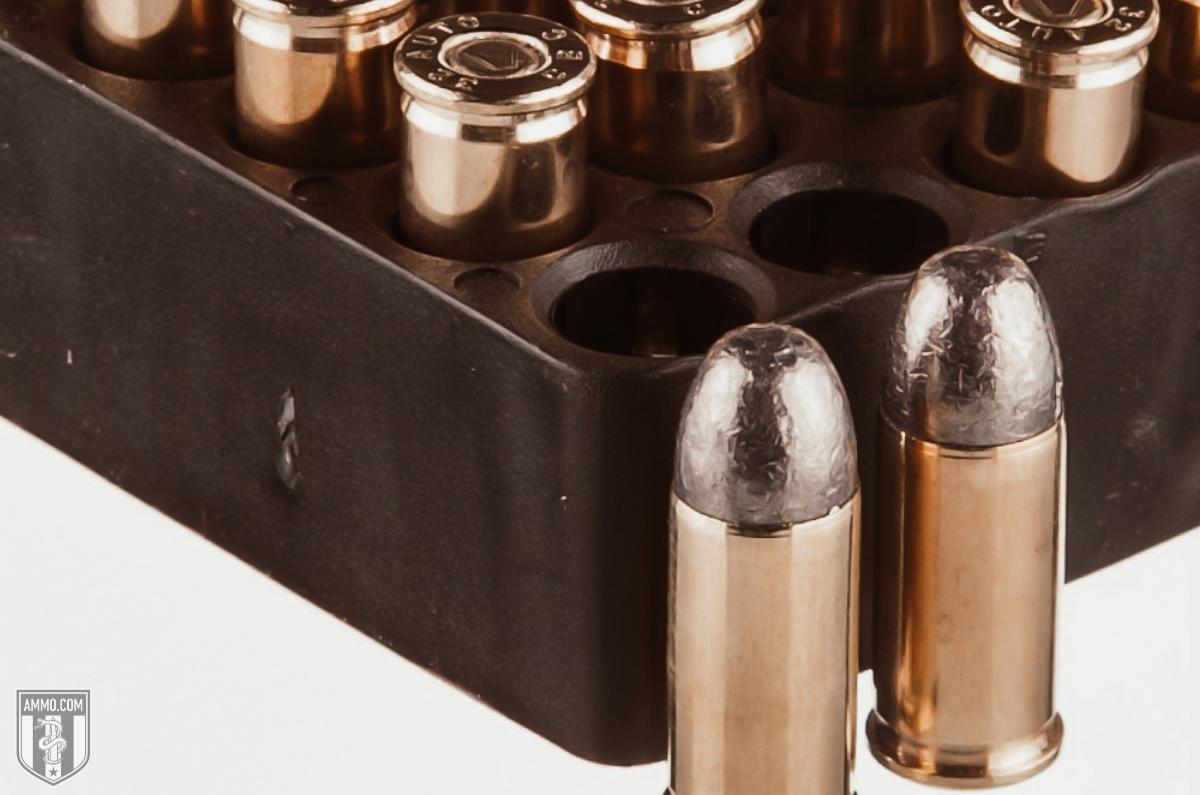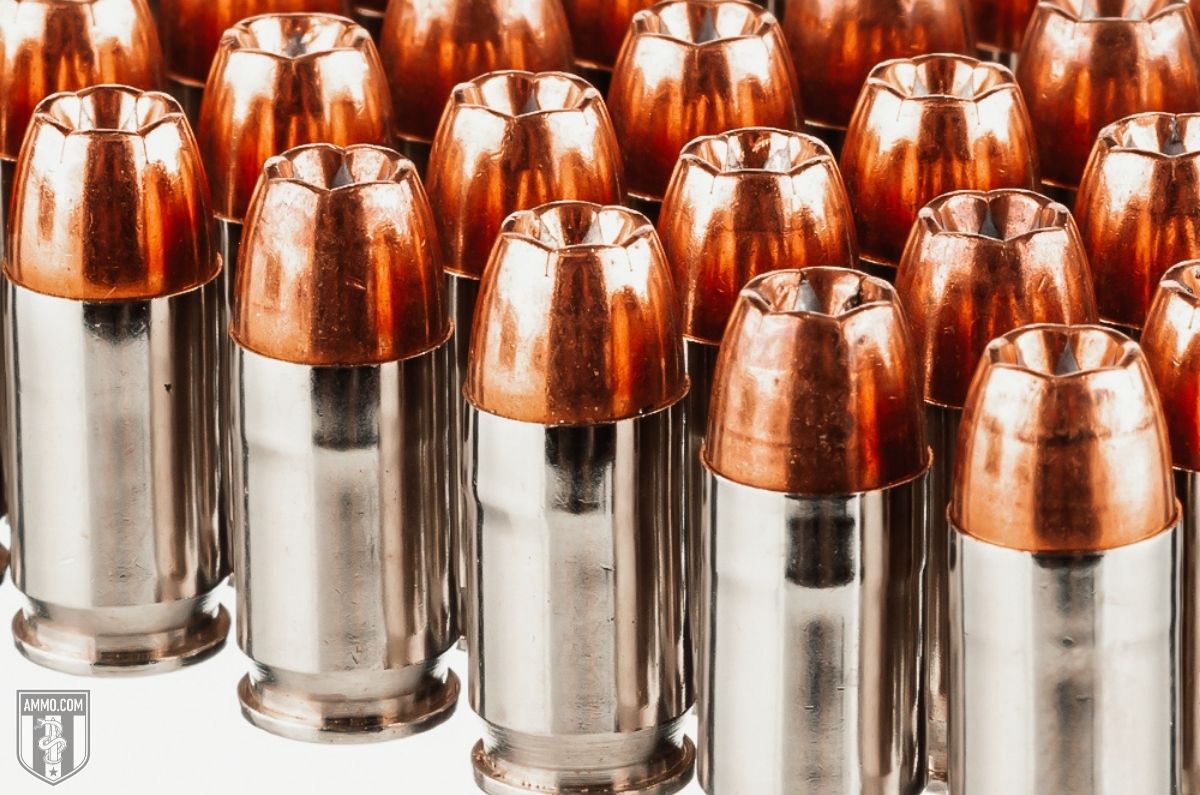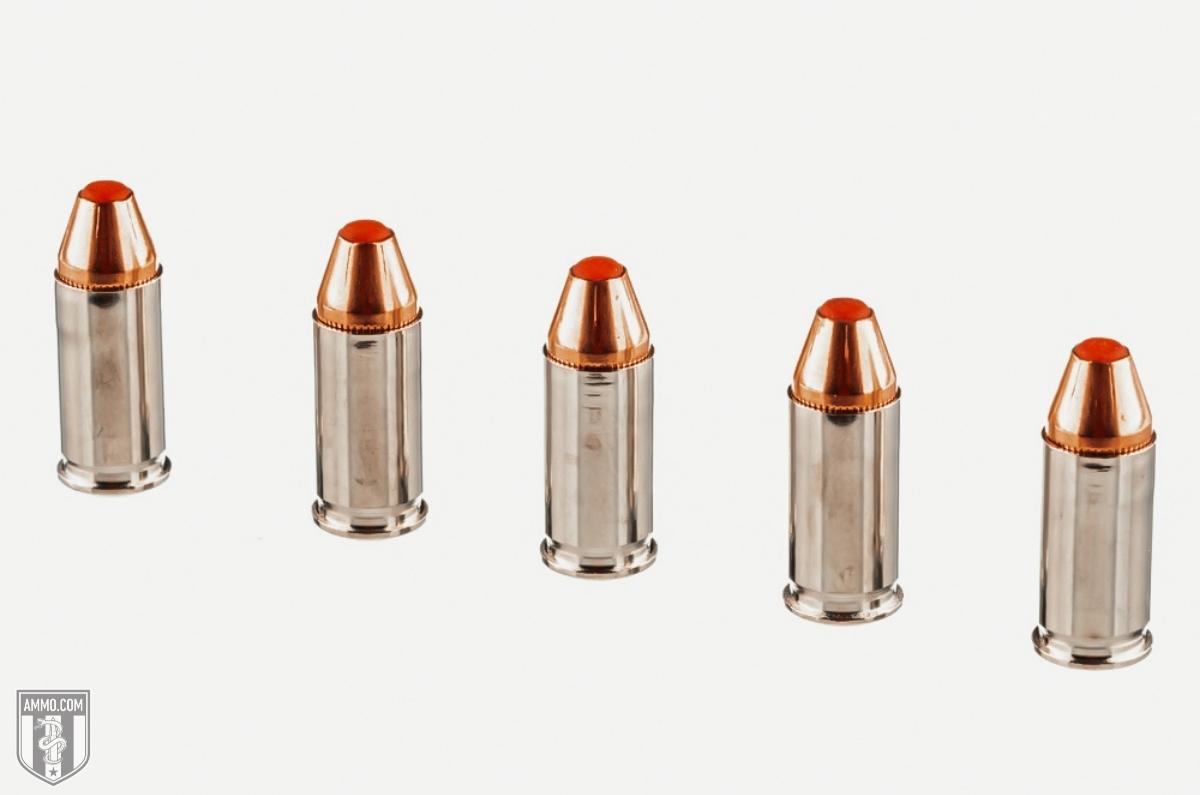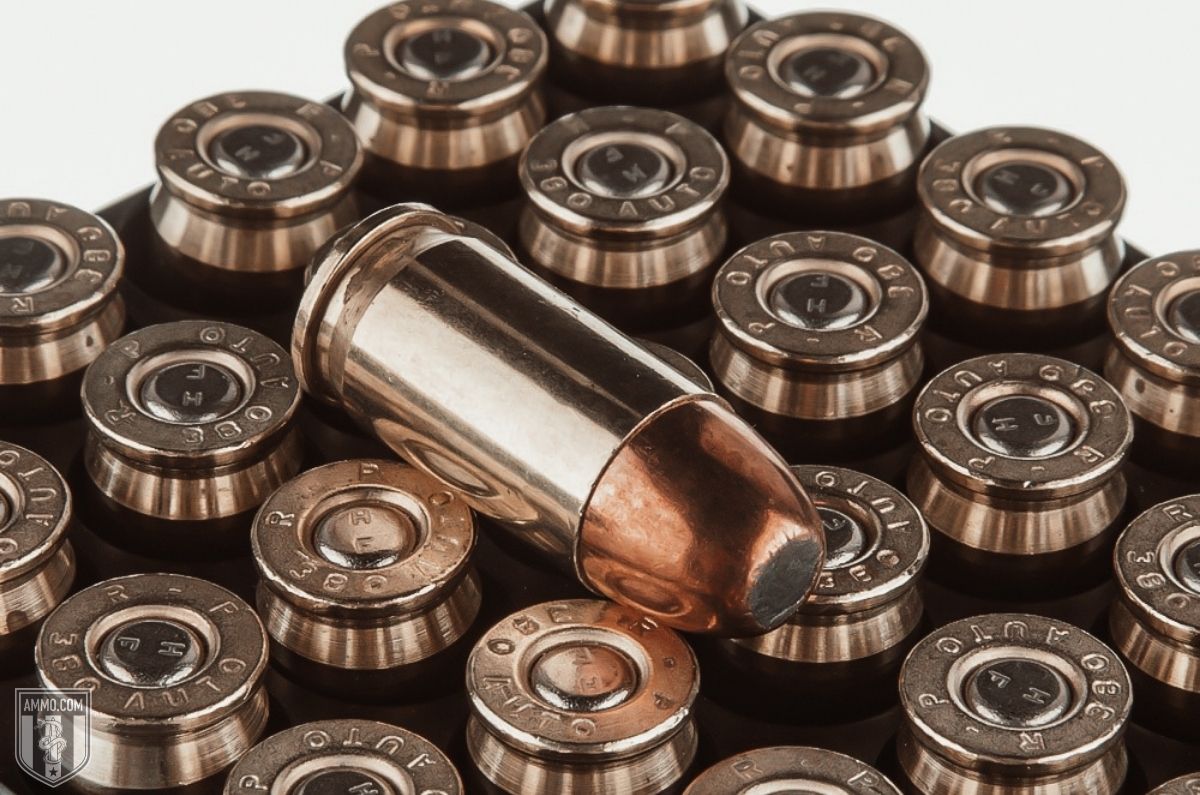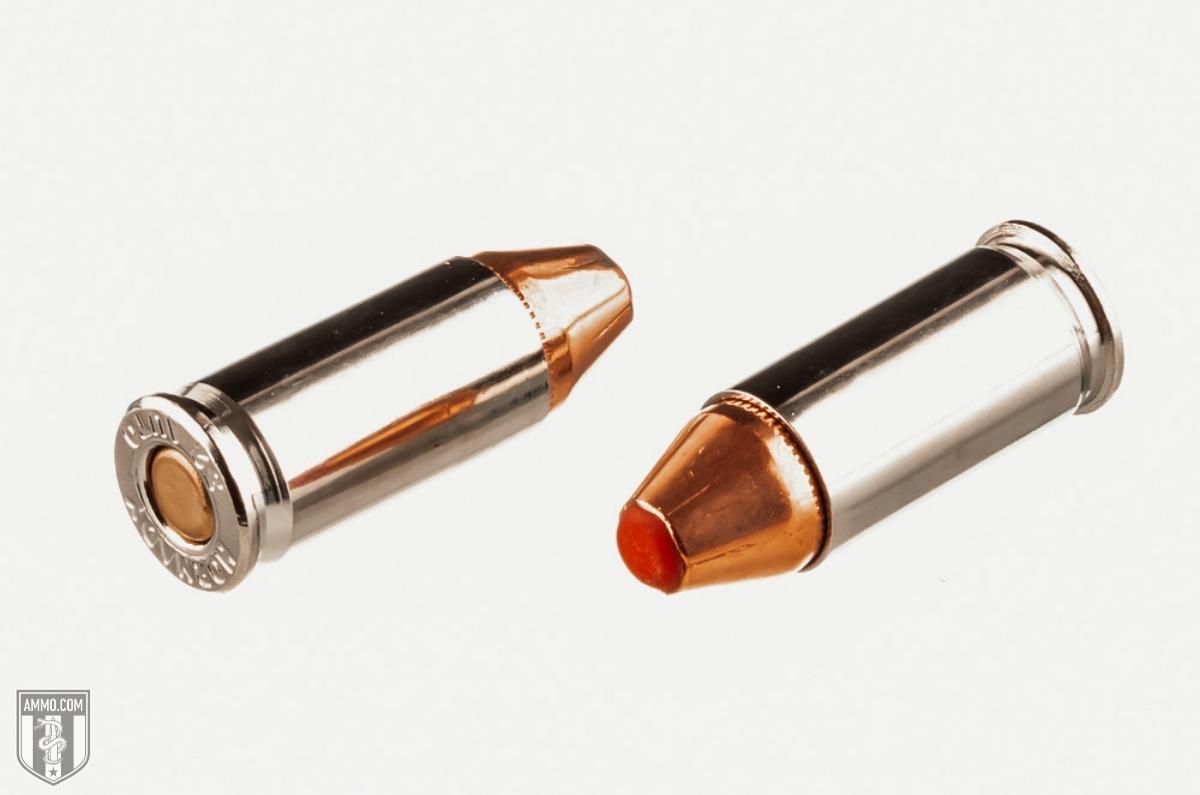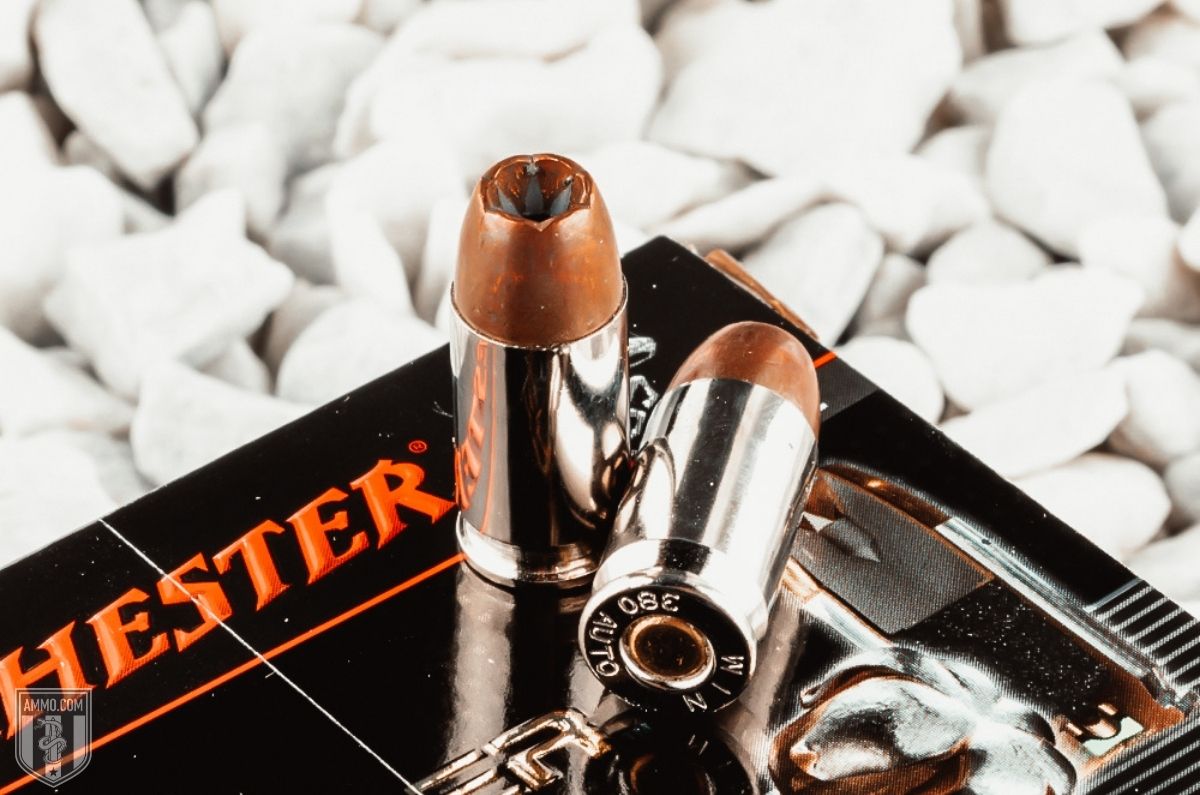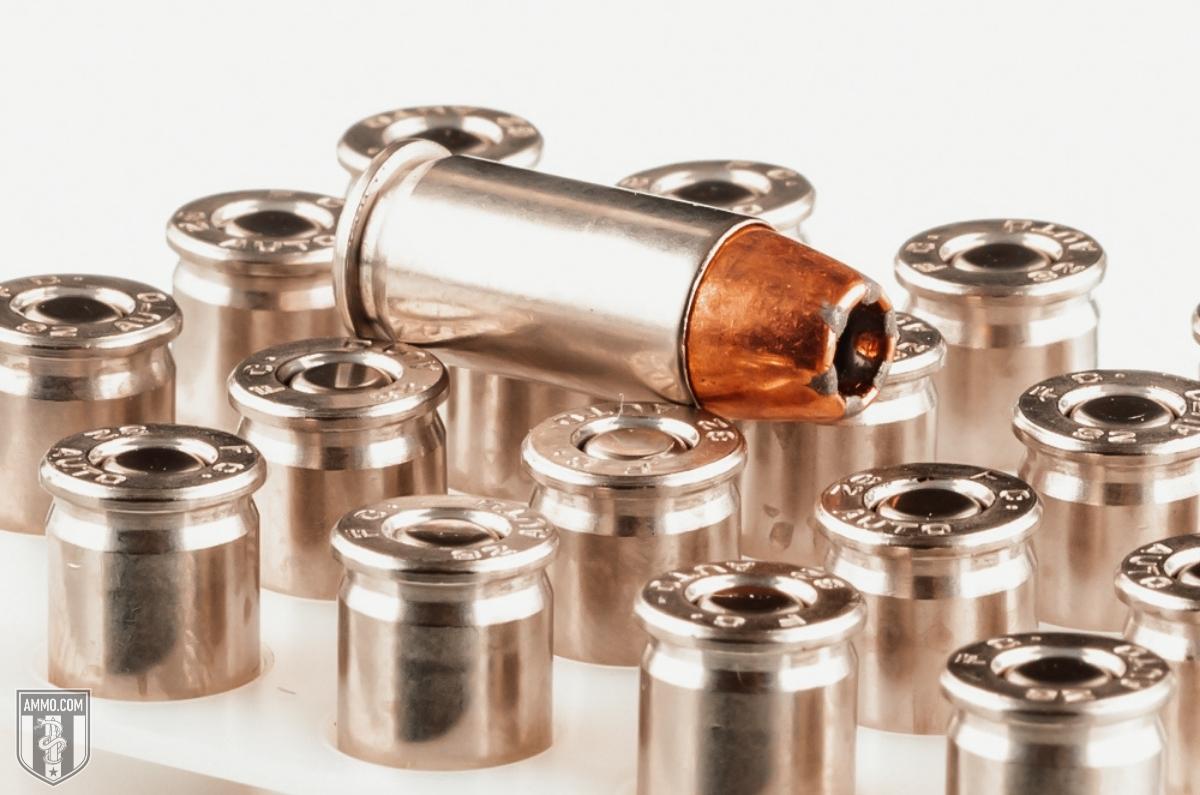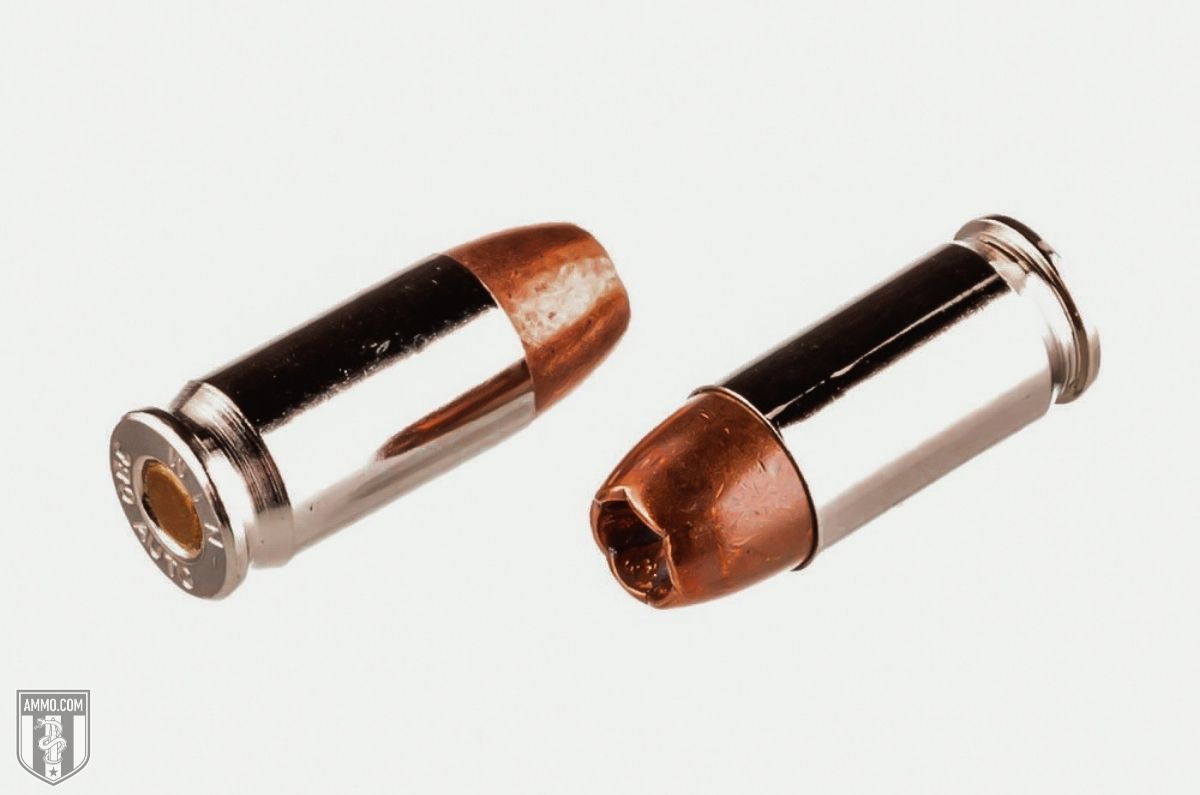32 ACP vs 380 ACP: The Automatic Colt Pistol Rivalry
 Many gun enthusiasts will scoff at carrying a .32 Auto or .380 Auto.
Many gun enthusiasts will scoff at carrying a .32 Auto or .380 Auto.
They'll make claims about not having as much knockdown power as larger calibers; while their claims are accurate, these same individuals often overlook the benefits of small caliber pistols.
That's why we're going to compare the 32 ACP vs. 380 ACP, so each caliber gets a fair evaluation.
After you've finished this article, you'll know if you should purchase either caliber. If so, which one is best for you?
.32 ACP vs .380 ACP
John Moses Browning created both calibers within a decade of each other for similar reasons, and they're similar in size.
So we shouldn't expect that much difference between the two calibers.
Let's find out just how different they are-
Cartridge Specs
The .32 Auto bullet measures between .308" and .3125". The bullet sits in a .680" long semi-rimmed straight-walled case. Which means the overall cartridge length comes in just under an inch at 0.984".
In Europe, they call the .32 ACP the 7.65mm Browning. It's designed for semi-auto handguns and has been chambered in more guns than any other cartridge in history.
.380 ammo is a rimless straight-walled case with a bullet weight of 85-95gr and a bullet diameter of .355". The cartridge's overall length is 0.984".

It's no surprise that these two cartridges look nearly identical, with the primary difference being the rim diameters of 0.358" for the .32 ACP cartridge and 0.374" for the .380 ACP cartridge. So if you decide to get both, be sure to pay attention to which one you're loading into what gun.
.380 vs. .32: Recoil
Recoil is determined most by the amount of powder, bullet weight, gun weight, and the shooter.
It's important to consider because some people are more sensitive to recoil than others. This can make them less accurate and slower on follow-up shots, which could be costly during a self-defense situation.
As a child, I would flinch before I pulled the trigger because I was anticipating the recoil, making me less accurate and slower to send the next round downrange.
Thankfully, I outgrew this bad habit due in part to downsizing calibers and then working my way back up to larger calibers with more recoil.
Both calibers were designed for a small pocket pistol, so neither packs a punch and the primary reason many smaller framed individuals prefer to shoot .380 ACP vs. 9mm.
I love shooting my 9mm Smith & Wesson Shield. However, my wife found it to be too much felt recoil for her, so we bought her a .380 Auto pistol, and she loves it.
Comparing the recoil of these two calibers is nothing like comparing the 9mm vs. .45 ACP. The recoil difference between the .380 ACP vs. .32 ACP is minimal.
Since we need a winner, the .32 ACP will have less recoil than the .380 ACP because it shoots lighter bullets.
Trajectory
Neither of these pistol calibers was intended for long-distance shooting, so the trajectory of both is unimpressive.
However, there have been a few attempts to use machine guns chambered in the .380 ACP. They were intended for close combat, but the extra barrel length slightly extends the range of the .380 Auto.
Since these calibers are primarily for self or home defense, you shouldn't need to worry about the trajectory because most of these scenarios happen well within 25 yards, and the .32 ACP is still flat shooting at that distance.
This section is a tie.
Accuracy
The gun and the shooter primarily determine accuracy. Most shooters will find they are more accurate with specific guns than others. Recoil also affects accuracy to a degree.
As you know, accuracy is crucial because you need to be able to hit the target at which you're aiming. This is for your safety and the safety of those around you.
It's for your safety because the more accurate you are, the quicker you can stop a threat, and it's for the protection of others because you're bullets will be hitting the target instead of people near the danger.
An average shooter will be very accurate with the .380 Auto or the .32 Auto because the low recoil of both calibers contributes to increased accuracy. The accuracy of follow-up shots at close distances is also higher with both calibers.
Therefore, this category is also a tie.
.32 vs. .380: Stopping Power
The stopping power of both calibers is relatively weak.
However, stopping power is an overrated metric.
Now let me explain before you call in the calvary!
A .22 LR bullet in the vitals will stop someone faster than a .45 ACP bullet in the hand. So shot placement is critical.
With that said a poorly placed .45 ACP round will do more damage than a poorly placed .22 LR. That's why many people compromise and choose to carry a 9mm or .380 Auto, but most overlook the .32 Auto.
There is no scientific process to determine stopping power; however, the general rule of thumb is that the larger the bullet, the more stopping power it has because it leaves a bigger hole and it's heavier.
The bullets are very similar when shooting ballistics gelatin, except the .380 bullet leaves a slightly larger hole because of its larger diameter. It also travels deeper into the ballistics gel because it has more mass, so it will take more force to stop it.
The bullet type also factors into this equation. A jacketed hollow point (JHP) will cause more damage than a full metal jacket (FMJ) because the JHP expands and fragments which cause more damage, therefore, more stopping power.
With all things as equal as possible, the .380 ACP bullet has more stopping power than the .32 ACP bullet.
The .380 ACP ammo wins this round.
Hunting
For most hunting scenarios, you'll want a rifle caliber; however, if you're determined to hunt with a handgun, I suggest stepping up to a large round like a .44 Magnum.
The .32 Auto and the .380 Auto can be used to hunt small game like rabbits and other small varmints, but their projectiles don't have the knockdown power to ethically harvest anything larger than a groundhog from any considerable distance.
The .380 ACP snake shot ammo is an excellent round for small reptiles and rodents like rats.
Even carrying either of these calibers in a backup gun isn't advised by big-game hunters.
The .32 ACP and .380 ACP are powerful enough to put down a suffering animal humanely, they both require well-placed shots, and you're unlikely to have an opportunity to take a well-placed shot if you're using either one as a backup.
That's why it's best to stick with more powerful rounds for all hunting situations. However, if I were forced to choose between these calibers to go hunting with, I would choose the .380 Automatic Colt Pistol.
.32 ACP vs. .380 ACP: Self-Defense & Home Defense
I feel like I've repeated myself several times, saying, "these calibers weren't designed with this in mind."
Well, that stops now.
Self-defense and home defense are precisely why these calibers were created.
Despite what many claim, both calibers shine in concealed carry situations. They're often chambered in small, easily concealable hammerless pistols and have a decent magazine capacity.
As we've already discussed, the primary drawback of using these calibers for self-defense is their lack of firepower, but that shouldn't discount them from the discussion because stopping power isn't everything.
My wife's go-to gun for concealed carry or home defense is her Kimber chambered in .380 Auto ammo because it has low recoil, and the small frame fits her hands well; she would be much more reluctant to pull the trigger of my .45 Auto, plus it's difficult for her to grip correctly.
Another reason why you should consider the .32 ACP or .380 ACP as a viable self and home defense round is that they're less likely to penetrate walls, which means your family and neighbors are safer from friendly fire.
I still prefer my 12 gauge or 20 gauge shotguns for home defense over my pistols to help cut down on the chance of harming an innocent bystander.
For concealed carry purposes, I prefer to have a .380 ACP in my waistband over a .32 ACP because it has greater knockdown power and the same amount of round capacity as most .32 Auto pistols.
The winner of this section is the .380 Auto.
Ammo Cost & Availability
The cost of ammo has skyrocketed in the last several years while the availability has plummeted.
Economics 101, when supply is low and demand is high, the price goes up.
It's pointless to purchase a gun that's chambered for a round that's impossible to buy unless you're into really cool paperweights.
However, if you like me and prefer to shoot your gun, I suggest purchasing firearms in standard calibers like .32 Auto and .380 Auto.
The drawback is that many other people have these calibers, so when demand increases, they're usually one of the first rounds people grab. This also means they're one of the first that ammo manufacturers begin making, so supplies shouldn't be low for long.
While the .32 Browning Auto is older and chambered in more handguns than any other caliber, it's begun to decline in popularity; therefore, ammo makers don't manufacture it as much as they do .380 ammo.
Surprisingly .32 ACP ammo is cheaper than .380 ammunition in most instances. The price of ammo for .32 ACP caliber guns varies depending on bullet type and brand but expect to pay at least $0.60 per round. Because it is declining in popularity, the ammo is becoming more challenging to find compared to .380.
You can find .380 ACP ammo for as cheap as $0.50 per round; however, you're more likely to find it in the $1- $1.50 per round range, especially if you're looking for self-defense ammo.
Speaking of ammo price make sure to check out our stock of Hornady 380 ammo, Remington 380 ammo, PMC 380 ammo, Blazer Brass 380 ammo and Fiocchi 380 ammo to compare prices.
Since this caliber is more popular, it has a broader selection of bullet types and loads. Most ammo manufacturers like Remington, Federal, Cor-Bon, Fiocchi, Speer, Blazer, and Hornady produce ammo for the .380 ACP.
I give the edge to the .380 Auto for this category because it's easier to find ammo, and it's not much more expensive.
Gun Cost & Availability
If you're like me, then you don't have an unlimited budget for firearms; otherwise, I'd need a much larger safe!
That often means I'm searching for good deals when buying my next gun, and the price tends to be a significant factor in convincing my wife that I need this gun.
If a gun is hard to find, then the price will increase. I tried to keep this in mind while researching both calibers.
Many shooters love the Ruger LCP, which is chambered in .380 Auto because it's lightweight, easy to conceal, and inexpensive. Depending on the upgrades you wish to add, you'll be able to pick one up for around $300.
Several other popular pistols chambered in .380, like the Glock 43, Sig Sauger P238, Walther PK38, and the Kel-Tec P-3AT. Each varies in price, but most are readily available.
As far as guns chambered in .32 Auto goes, there are several to choose from, like the Beretta Tomcat, Kel-Tec P-32, and the North American Arms Guardian .32 ACP pistol. These also vary in price, but you should expect to pay a similar amount for a .32 ACP handgun as you would for a .380 ACP gun.
This section is a tie because the availability of the guns and the costs are so similar.
Reloading the .380 ACP Vs .32 ACP
Reloading is one of the best ways to save money on ammunition and control the controllable variables.
Some rounds are better suited for handloading than others. For instance, the .22 LR is difficult to handload because it's a rimless cartridge.
That's not the case for the .380 Auto or the .32 Auto. They both are straight-walled centerfire cartridges which makes them ideal for reloading. The bullets are reasonably abundant and common, and depending on which powder and primers you choose, they shouldn't be difficult to find.
The reloading equipment is readily available, which means if you're making your decision solely based on reloading, it's a close call.
The one advantage the .380 has would be that it uses the same bullet as the 9mm. This is good because a lot of companies will manufacture it, but it also means that lots of reloaders want that bullet, so demand for it is also high.
The .380 is the more popular round, so, in theory, the reloading supplies should be more abundant. Therefore, we will give the narrow victory to the .380 Automatica Colt Pistol.
Ballistics
The ballistics advantage goes to the .380 but check out these ballistics tables the team at AMMO.com created to see how each round compares using similar ammo.
.32 ACP Ballistics
Note: This information comes from the manufacturer and is for informational purposes only. The actual ballistics obtained with your firearm can vary considerably from the advertised ballistics. Also, ballistics can vary from lot to lot with the same brand and type load.
| 32 ACP Bullet WEIGHT | Muzzle VELOCITY (fps) | Muzzle ENERGY (ft. lbs.) | Mid-Range TRAJECTORY (in.) | Barrel Length (in.) | |||||
|---|---|---|---|---|---|---|---|---|---|
| Muzzle | 50 yds. | 100 yds. | Muzzle | 50 yds. | 100 yds. | 50 yds. | 100 yds. | ||
| 60 Grain JHP | 910 |
n/a | n/a | 125 | n/a | n/a | n/a | n/a | n/a |
| 60 Grain | 970 | 895 | 835 | 125 | 105 | 95 | 1.3 | 5.4 | 4" |
| 60 Grain | 1000 |
917 | 849 | 133 | 112 | 96 | n/a | n/a | 4" |
| 71 Grain FMJ | 800 | n/a | n/a | 100 | n/a | n/a | n/a | n/a | n/a |
| 71 Grain FMJ | 850 | n/a | n/a | 114 | n/a | n/a | n/a | n/a | n/a |
| 71 Grain FMJ | 905 | n/a | n/a | 129 | n/a | n/a | n/a | n/a | n/a |
| 71 Grain | 905 | 855 | 810 | 130 | 115 | 95 | 1.4 | 5.8 | 4" |
.380 ACP Ballistics
Note: This information comes from the manufacturer and is for informational purposes only. The actual ballistics obtained with your firearm can vary considerably from the advertised ballistics. Also, ballistics can vary from lot to lot with the same brand and type load.
| 380 ACP (Auto) Bullet WEIGHT | Muzzle VELOCITY (fps) | Muzzle ENERGY (ft. lbs.) | Mid-Range TRAJECTORY (in.) | Barrel Length (in.) | |||||
|---|---|---|---|---|---|---|---|---|---|
| Muzzle | 50 yds. | 100 yds. | Muzzle | 50 yds. | 100 yds. | 50 yds. | 100 yds. | ||
| 60 Grain | 1130 | 960 | n/a | 170 | 120 | n/a | 1 | n/a | n/a |
| 75 Grain | 950 | n/a | n/a | 183 | n/a | n/a | n/a | n/a | 3" |
| 85 Grain | 990 | 920 | 870 | 190 | 165 | 145 | 1.2 | 5.1 | 4" |
| 85 Grain JHP | 1000 | n/a | n/a | 189 | n/a | n/a | n/a | n/a | n/a |
| 88 Grain | 990 | 920 | 870 | 190 | 165 | 145 | 1.2 | 5.1 | 4" |
| 90 Grain JHP | 900 | n/a | n/a | 162 | n/a | n/a | n/a | n/a | n/a |
| 90 Grain | 1000 | 890 | 800 | 200 | 160 | 130 | 1.2 | 5.5 | 3.75" |
| 95 Grain FMJ | 900 | n/a | n/a | 171 | n/a | n/a | n/a | n/a | n/a |
| 95 Grain | 955 | 865 | 785 | 190 | 160 | 130 | 1.4 | 5.9 | 4" |
| 100 Grain | 955 | 865 | 785 | 190 | 160 | 130 | 1.4 | 5.9 | 4" |
| 90 Grain JHP +P | 1200 | n/a | n/a | 200 | n/a | n/a | n/a | n/a | n/a |
.32 Auto History
The .32 Automatic Colt Pistol cartridge traces its origins back to John Moses Browning. In 1899 he designed this cartridge for the Fabrique Nationale 1900 blowback pistol.
In 1903, the Colt Model 1903 Pocket Pistol hit the market in the US, which only helped increase its popularity. It's no surprise that other firearms manufacturers began releasing their semi-automatic pistols chambered in .32 ACP.
The .32 ACP was carried by law enforcement and militaries around the world. It's also played its part in assassinations, suicides, and movies. This caliber was popular for several reasons, good and bad.
.380 Auto History
Not surprisingly, the .380 ACP also traces its origins back to John Moses Browning. In 1908 the Colt Model 1908 Pocket Pistol was released, chambered in .380 ACP.
In 1912, when it was introduced in Belgium, it became known as the 9mm short. It remained popular through World War II and was the primary pistol caliber for militaries worldwide until the 9mm replaced it.
There are a few countries where the .380 ACP is still the official military pistol cartridge.
Final Shots: 380 vs. 32 ACP
If I've said it once, I've said it a thousand times; these rounds are very similar. However, the differences show why John Browning created the .380 ACP.
He definitely improved upon his original design. It's hard to argue with over 100 years of use, and it shows no signs of going away anytime soon.
While I would choose the .380 over the .32 ACP, there are a few instances when the .32 ACP should be the caliber you choose. If recoil is your primary concern, or you want to pretend you're James Bond while carrying a Walther PPK.
Otherwise, when comparing the 32 ACP vs 380 ACP, you should choose the .380 Automatic Colt Pistol.
Ammo Comparisons
- .308 vs 5.56
- 6.5 Creedmoor vs .308
- .300 Blackout vs .308
- .300 Win Mag vs .308
- .243 vs .308
- .308 vs .30-06
- 7mm-08 vs .308
- .270 vs .308
- 7.62x39 vs .308
- .223 vs .308
- .338 Lapua vs .308
- .380 ACP vs 9mm
- .223 vs 5.56
- .300 Blackout vs 5.56
- 9mm vs 45 ACP
- 9mm vs 40 S&W
- .357 SIG vs 9mm
- 10mm vs 9mm
- 9mm vs 9mm Luger
- .243 vs .270
- .300 Win Mag vs .30-06
- .270 vs .30-06
- .40 vs .45
- 38 Special vs 357
- 9mm vs 40 vs 45
- 5.56 vs 7.62x39
- 338 Lapua vs .30-06
- .30-30 vs .30-06
- 300 PRC vs 338 Lapua
- .30-06 vs 7mm
- 300 Win Mag vs 338 Lapua
- 300 PRC vs 300 Win Mag
- 300 WSM vs 300 Win Mag
- 338 Win Mag vs 338 Lapua
- 12 Gauge vs 20 Gauge
- 10mm vs 357 Mag
- .30-30 vs 7.62x39
- 224 Valkyrie vs 22-250
- 17 HMR vs 22 Mag
- 7.62x39 vs .300 Blackout
- 45 ACP vs 45 Auto
- 45-70 vs 30-30
- 300 Blackout vs 223
- 357 Magnum vs 9mm
- 350 Legend vs 300 Blackout
- 224 Valkyrie vs 223
- 45 ACP vs 38 Super
- 6.5 Grendel vs .308
- 17 HMR vs 22 LR
- 10 Gauge vs 12 Gauge
- 22-250 vs 223
- 45 Colt vs 45 ACP
- 350 Legend vs 30-30
- 5.7x28 vs 223
- 5.7 vs 9mm
- 5.56 vs 5.7
- 22 vs 9mm
- Buckshot vs Birdshot
- 450 Bushmaster vs 308
- 450 Bushmaster vs 223
- Buckshot vs Slug
- 6.5 Grendel vs 5.56 vs 223
- 6mm ARC vs 6.5 Grendel
- 44 vs 45
- 458 SOCOM vs 5.56
- 357 vs 44
- 32 ACP vs 380
- 300 Win Mag vs 338 Win Mag vs 338 Lapua Mag
- 450 Bushmaster vs 458 SOCOM vs 50 Beowulf
- 6mm Creedmoor vs 6.5 Creedmoor
- TMJ vs FMJ
- 44 Special Vs 44 Magnum
- 45 90 vs 45 70
- 6.8 Western vs 6.8 SPC
- 50 Beowulf vs 50 BMG
- 26 Nosler vs 6.5 PRC
- 28 Gauge vs 410
- 6.8 SPC vs 5.56
- 6.8 SPC vs 6.5 Grendel
- 6.8 Western vs 7mm Rem Mag vs .28 Nosler
- 6.8 Western vs 6.5 Creedmoor
- 22 Hornet vs 223
- 6.8 Western vs 6.5 PRC
- .410 vs 12 Gauge
- .410 vs 20 Gauge
- 22 LR vs 22 Mag
- 6mm ARC vs 243
- 7mm-08 vs 270
- 243 vs 6.5 Creedmoor
- Nickel vs Brass Casing
- 204 Ruger vs 223
- 50 Beowulf vs 5.56
- 260 Remington vs 6.5 Creedmoor
- 6mm Remington vs 243
- 28 Nosler vs 300 PRC
- 50 Beowulf vs 50 AE
- 22 Nosler vs 22-250
- 450 Marlin vs 45-70
- 300 Win Mag vs 300 Norma
- 458 SOCOM vs 300 Blackout
- 38-55 vs 45-70
- 22 Hornet vs 22 LR
- 300 Norma vs 338 Lapua
- 338 Lapua vs 50 BMG
- 28 Nosler vs 300 Win Mag
- 28 Nosler vs 6.5 Creedmoor
- 204 vs 22-250
- 458 SOCOM vs 45 70
- 44 40 vs 45 70
- 6.8 SPC vs 6.5 Creedmoor
- 450 Bushmaster vs 30-06
- 7mm Rem Mag vs 300 Win Mag
- 30 Carbine vs 223
- 25-06 vs 30-06
- 26 Nosler vs 28 Nosler
- 16ga vs 12ga
- 30 06 vs 7.62 x54R
- 9mm Makarov vs 9mm Luger
- 350 Legend vs 223
- 30 Carbine vs 5.56
- 6.5x55 vs 6.5 Creedmoor
- 6.5 Creedmoor vs 270 vs 25-06
- M193 vs M855
- 450 Bushmaster vs 458 SOCOM
- 6.5 Grendel vs 6.5 Creedmoor
- 350 Legend vs 5.56
- .277 Fury vs 6.8 SPC
- 277 Fury vs 300 Win Mag
- 10mm vs .45 ACP
- 277 Fury vs 223
- 6.8 SPC vs 300 Blackout
- 6.5 PRC vs 6.5 Creedmoor
- 277 Fury vs 308
- 277 Fury vs 6.5 Creedmoor
- 350 Legend vs 450 Bushmaster
- 277 Fury Vs 5.56 NATO
- 10mm vs 40S&W
- 32 ACP vs 9mm
- 32 Special vs 9mm
- 8.6 Blackout vs 300 Blackout
- 30 Super Carry vs. 9mm
- 5.56 vs 9mm
- .50 Action Express vs 9mm
- 7.62x25 vs. 9mm
- 10mm vs 44 Magnum
- 300 Blackout vs 300 Win Mag
- 6.5 Grendel vs 300 Blackout
- 460 Rowland vs 10mm
- 300 RUM vs 300 PRC
- 300 Norma vs 300 PRC
- 45 GAP vs 45 ACP
- 7mm PRC vs 300 Win Mag
- 300 PRC vs 6.5 Creedmoor
- 300 PRC vs 308
- 357 SIG vs 357 Mag
- 7.62x39 vs 7.62x51
- 243 Win vs 223 Rem
- 30 Nosler vs 300 PRC
- 6.5 Creedmoor vs. 30-06 Springfield
- 450 S&W vs. 44 Magnum
- 6.5 Creedmoor vs. 300 Win Mag
- 454 Cassull vs. 45-70 Govt
- 454 Cassull vs. 44 Mag
- 7.62x54r vs. 308 Winchester
- 22 ARC vs. 223 Rem
- Subsonic vs. Supersonic Ammo

